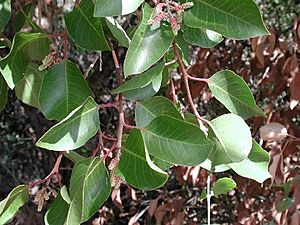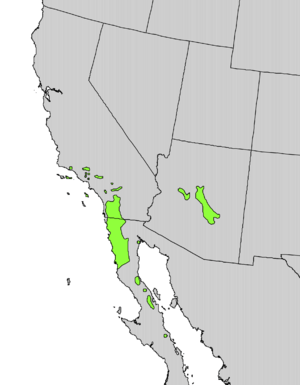Sugar sumac facts for kids
Quick facts for kids Sugar sumac |
|
|---|---|
 |
|
| Scientific classification | |
| Genus: |
Rhus
|
| Species: |
ovata
|
 |
|
| Natural range | |
The Rhus ovata, also known as sugar sumac or sugar bush, is a green plant that stays green all year. It can be a shrub or a small tree. You can find it growing in dry, sunny places like canyons in Southern California, Arizona, and Baja California.
Contents
Where Sugar Sumac Grows
Sugar sumac mostly grows in Southern California near the Pacific Ocean. It also grows in parts of Arizona and Baja California in Mexico. This plant likes dry areas and sunny hillsides. Sometimes, it can mix with another plant called Rhus integrifolia.
What Sugar Sumac Looks Like
The sugar sumac plant can grow from about 6.5 feet (2 meters) to 33 feet (10 meters) tall. It often has a round shape. Its branches are thick and have a reddish color.
The leaves are dark green and feel a bit leathery. They are shaped like an oval and are usually folded along the middle line. Each leaf grows by itself along the stem.
Flowers and Fruit
Sugar sumac blooms in April and May. Its small flowers grow in bunches at the ends of the branches. They look pink from a distance. If you look closely, you'll see they have white to pink petals and red parts underneath called sepals.
After the flowers, the plant grows small, reddish fruits. These fruits are sticky and about 6 to 8 millimeters wide. They are called drupes, which means they have a hard pit inside, like a peach.
How to Tell it Apart
Rhus ovata looks a lot like another plant called Rhus integrifolia. But you can usually tell them apart by their leaves. The leaves of Rhus ovata are often folded and have a more pointed tip. The leaves of Rhus integrifolia are usually flatter and more rounded.
Animals and Sugar Sumac
The fruits and flowers of the sugar sumac are a favorite food for many birds and butterflies. The plant itself also provides a good place for birds to live and hide. It's an important part of the local habitat.
How People Use Sugar Sumac
Native American groups like the Cahuilla used sugar sumac for medicine. They used it to help with colds and coughs. The Kumeyaay people used it to help make childbirth easier.
Growing Sugar Sumac
Sugar sumac is a very tough plant that doesn't need much water once it's grown. It likes sunny spots with soil that drains water well. It's a great plant for gardens in dry areas. If it needs to be trimmed, like to help prevent wildfires, it's best to do it in the fall.
Eating the Fruit
The fruit of the sugar sumac is edible, but you don't eat the large seeds. People can use the fruit to make a drink that tastes a bit like lemonade. Native Americans also used the fruit as a natural sweetener. Birds love to eat the fruit too!

